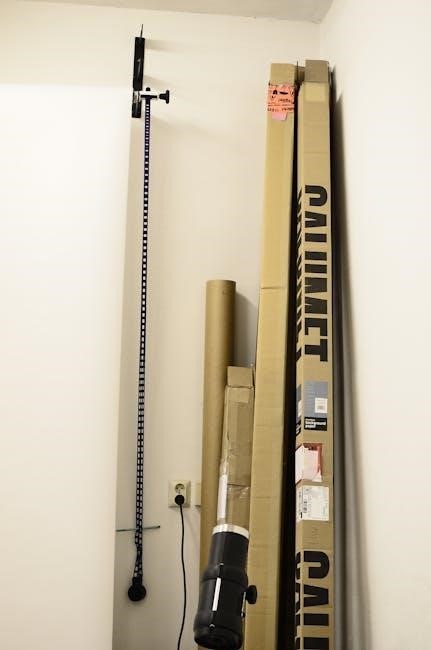Manual and automatic transmissions differ primarily in gear-shifting mechanisms. Manual requires driver clutch engagement, while automatic uses a torque converter for seamless shifts, affecting performance, fuel efficiency, and driving experience.
1.1 Definition and Basic Functionality
Manual transmission requires the driver to manually change gears using a clutch pedal and gearshift, offering control over gear selection. Automatic transmission uses a torque converter to automatically shift gears, eliminating the need for manual intervention, providing ease of use and smooth acceleration in various driving conditions.
1.2 Importance of Understanding the Differences
Understanding the differences between manual and automatic transmissions is crucial for making informed decisions about purchase, maintenance, and driving preferences. It impacts fuel efficiency, performance, and overall driving experience, helping drivers choose the best option for their lifestyle and budget.
Mechanical Components of Manual and Automatic Transmissions
Manual transmissions use a clutch and gear system, while automatics rely on a torque converter and hydraulic system to manage gear shifts without driver input.
2.1 Gears and Clutch in Manual Transmissions
In manual transmissions, gears are selected manually using a gearshift, while the clutch disengages engine power during shifts. This system relies on driver input for smooth operation, offering precise control over acceleration and deceleration. The clutch pedal must be pressed to disconnect the engine from the transmission, allowing the driver to shift gears without grinding. This mechanical process enhances driver engagement and typically improves fuel efficiency compared to automatics, as it eliminates the need for a torque converter and associated hydraulic systems. However, it requires more skill and effort, especially in heavy traffic, where frequent shifting can become tiresome. The gears in a manual transmission are usually fewer in number but more straightforward in design, contributing to lower production and maintenance costs. Additionally, the absence of complex components like planetary gears and multiple clutches simplifies the overall structure, making manual transmissions lighter and more durable in certain driving conditions. Despite these advantages, the need for constant driver involvement can be a drawback for those seeking a more convenient driving experience. Overall, the gears and clutch system in manual transmissions provide a direct connection between the driver and the vehicle, fostering a more immersive driving experience.
2.2 Torque Converter and Hydraulic System in Automatic Transmissions
In automatic transmissions, the torque converter replaces the manual clutch, enabling smooth gear transitions without driver input. It uses transmission fluid to transfer engine power to the gearbox. The hydraulic system, powered by fluid pressure, engages clutches and bands to shift gears automatically. This system provides convenience and ease of use, especially in stop-and-go traffic, but can reduce fuel efficiency compared to manual transmissions due to added complexity and energy loss in the torque converter.
Fuel Efficiency Comparison
Manual transmissions are generally more fuel-efficient than automatics due to lower energy loss. Automatics, especially older models, often consume more fuel because of the torque converter.
3.1 Manual Transmission Fuel Efficiency
Manual transmissions typically offer better fuel efficiency due to their simpler design and lack of energy-loss components like torque converters. This results in more direct power transfer and improved gas mileage, especially in city driving. However, efficiency can vary based on driving habits and specific vehicle models.
3.2 Automatic Transmission Fuel Efficiency
Automatic transmissions generally have lower fuel efficiency compared to manuals due to components like torque converters and planetary gears, which introduce energy loss. However, advancements in technology, such as continuously variable transmissions (CVTs) and dual-clutch systems, have improved efficiency, narrowing the gap between automatic and manual transmissions in some modern vehicles.

Driving Experience and Ease of Use
Manual transmissions offer more driver engagement and control, requiring clutch and gear shifts, while automatic transmissions provide ease and convenience, especially in heavy traffic conditions.
4.1 Driver Involvement in Manual Transmissions
Manual transmissions require active driver involvement, as shifting gears and using the clutch demands constant attention. This engagement enhances control over acceleration and deceleration, offering a more connected driving experience. However, it can be tiresome in heavy traffic, as frequent clutch presses and gear changes are necessary to maintain smooth operation.
4.2 Convenience andEase of Automatic Transmissions
4.2 Convenience and Ease of Automatic Transmissions
Automatic transmissions provide unparalleled convenience, eliminating the need for manual gear shifting. Drivers can focus solely on steering, making urban driving and heavy traffic less stressful. The absence of a clutch pedal also simplifies operation, especially for newcomers, while the torque converter ensures smooth transitions between gears without driver intervention.

Cost Differences
Manual transmissions are generally cheaper to purchase and maintain than automatics. Automatics have higher upfront costs due to complex components but offer improved long-term efficiency.
5.1 Purchase Cost of Manual vs. Automatic
Manual transmissions are typically more affordable during purchase. They have fewer components, reducing manufacturing costs. Automatics, with their complex systems like torque converters, are pricier upfront. This cost difference is significant for budget-conscious buyers.
5.2 Maintenance and Repair Costs
Manual transmissions generally have lower maintenance and repair costs due to their simpler design. Automatics, with hydraulic systems and torque converters, are more complex and expensive to fix. Over time, automatics can incur higher costs, especially if major components fail. This makes manuals more economical for long-term ownership.

Performance and Acceleration
Manual transmissions typically offer better acceleration and control, allowing drivers to optimize gear shifts. Automatics, while smoother, may lack responsiveness, especially in high-performance scenarios.
6.1 Manual Transmission Performance
Manual transmissions deliver precise control over gear shifts, enabling better acceleration and responsiveness. Drivers can optimize engine power, especially in performance driving. However, constant engagement can be tiresome in heavy traffic.
6.2 Automatic Transmission Performance
Automatic transmissions provide smooth, seamless gear shifts through a torque converter, reducing driver effort. However, they may lack the precise control of manuals, sometimes shifting too early and reducing acceleration efficiency compared to manual transmissions.
Semi-Automatic and Dual-Clutch Transmissions
Semi-automatic and dual-clutch transmissions blend manual and automatic features. They use automated clutch systems or dual clutches for faster shifting, enhancing performance and driver experience.
7.1 Electrohydraulic Manual Transmission
An electrohydraulic manual transmission combines manual gear control with automatic clutch operation. It uses electronic controls to engage and disengage the clutch, eliminating the need for a clutch pedal. This system offers smoother shifts and reduced driver effort while maintaining the performance benefits of a manual transmission. It strikes a balance between manual control and automatic convenience, ideal for drivers seeking ease without losing engagement;
7.2 Dual-Clutch Transmission (DCT) Technology
Dual-Clutch Transmission (DCT) uses two clutches to pre-select gears, enabling rapid shifts without interrupting power delivery. One clutch manages odd gears, while the other handles even gears, allowing seamless transitions. DCT combines the efficiency of manual transmissions with the convenience of automatics, offering quick acceleration and improved fuel efficiency. It is ideal for performance-oriented vehicles, blending sporty driving with modern automation.
Advantages and Disadvantages
Manual transmissions offer better fuel efficiency and control but require constant driver engagement. Automatics provide ease and convenience but often cost more and may lack precision in shifting.
8.1 Advantages of Manual Transmissions
Manual transmissions offer superior fuel efficiency, better control over gear shifts, and typically lower purchase costs. They provide a more engaging driving experience, allowing drivers to connect more with the vehicle; Additionally, manual transmissions often require less maintenance and are lighter, contributing to improved performance and handling; They also tend to have longer lifespans if driven carefully.
8.2 Disadvantages of Manual Transmissions
Manual transmissions require constant driver engagement, involving clutch operation and gear shifting, which can be tiring in heavy traffic. They also demand more skill and practice to master, especially for new drivers; Additionally, improper clutch usage can lead to wear and tear, increasing maintenance costs over time. This makes manual transmissions less convenient in stop-and-go driving conditions compared to automatics.
8.3 Advantages of Automatic Transmissions
Automatic transmissions offer unparalleled convenience, eliminating the need for manual gear shifting and clutch operation. This makes them ideal for urban driving, heavy traffic, and new drivers. They provide smooth acceleration and reduce driver fatigue, allowing for a more relaxed driving experience. Additionally, automatics are easier to use, making them accessible to a broader range of drivers without requiring specialized skills.
8;4 Disadvantages of Automatic Transmissions
Automatic transmissions generally have higher purchase costs and lower fuel efficiency compared to manual counterparts. They also tend to have more complex mechanical components, leading to higher maintenance and repair expenses. Additionally, automatics can lack the driver engagement and precise control offered by manual transmissions, which some enthusiasts find less satisfying during spirited driving sessions.

Factors Influencing the Choice
Lifestyle, driving habits, and budget significantly influence the choice between manual and automatic transmissions. Daily commuting, traffic conditions, and personal preference for control or convenience play major roles.
9.1 Lifestyle and Daily Commuting Needs
Lifestyle and daily commuting needs significantly impact the choice between manual and automatic transmissions. Drivers in heavy traffic or urban areas often prefer automatics for convenience and reduced fatigue. Manual transmissions, while more engaging, require constant clutch and gear engagement, which can be tiresome in stop-and-go conditions. Personal preference for control versus ease also plays a role, as does the desire for fuel efficiency or smooth acceleration.
9.2 Budget and Maintenance Preferences
Budget and maintenance preferences influence transmission choice. Manual transmissions are typically cheaper to purchase and maintain, with fewer components prone to failure. Automatics, while more expensive upfront and in repairs, offer convenience and reduced driver effort. Maintenance costs for automatics can rise due to complex components like torque converters and hydraulic systems. Balancing initial cost, maintenance, and personal priorities is essential for most drivers.
The choice between manual and automatic transmissions depends on driving habits, lifestyle, and preferences. Consider factors like fuel efficiency, cost, and ease of use to decide.
10.1 Final Thoughts on Manual vs. Automatic
Manual transmissions offer better fuel efficiency and driver engagement but require more skill and effort, especially in traffic. Automatics provide convenience and ease but may lack the connection to the driving experience. Lifestyle, budget, and personal preference are key factors. Modern advancements like dual-clutch transmissions blur the lines, offering a balance of performance and convenience, making the choice more nuanced than ever.
